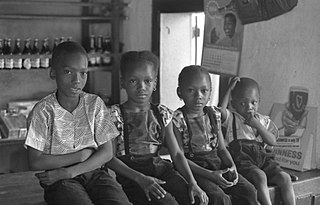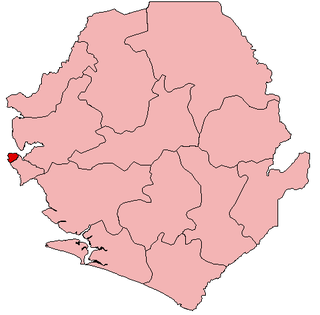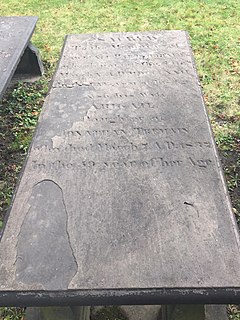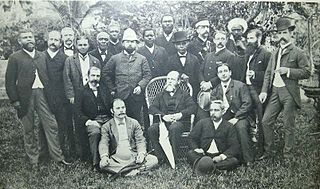
Sierra Leone, officially the Republic of Sierra Leone, informally Salone, is a country on the southwest coast of West Africa. It is bordered by Liberia to the southeast and Guinea to the northeast. Sierra Leone has a tropical climate with a diverse environment ranging from savanna to rainforests, a total area of 71,740 km2 (27,699 sq mi) and a population of 7,092,113 as of the 2015 census. The capital and largest city is Freetown. The country is divided into five administrative regions which are subdivided into sixteen districts.

Freetown is the capital and largest city of Sierra Leone. It is a major port city on the Atlantic Ocean and is located in the Western Area of the country. Freetown is Sierra Leone's major urban, economic, financial, cultural, educational and political centre, as it is the seat of the Government of Sierra Leone. The population of Freetown was 1,055,964 at the 2015 census.
Sierra Leonean Creole or Krio is an English-based creole language that is lingua franca and de facto national language spoken throughout the West African nation of Sierra Leone. Krio is spoken by 87% of Sierra Leone's population and unites the different ethnic groups in the country, especially in their trade and social interaction with each other. Krio is the primary language of communication among Sierra Leoneans at home and abroad. The language is native to the Sierra Leone Creole people or Krios,, and is spoken as a second language by millions of other Sierra Leoneans belonging to the country's indigenous tribes. English is Sierra Leone's official language, while Krio, despite its common use throughout the country, has no official status.
Fernandinos are creoles, multi-ethnic or multi-racial populations who developed in Equatorial Guinea. Their name is derived from the island of Fernando Pó, where many worked. This island was named for the Portuguese explorer Fernão do Pó, credited with discovering the region.

The Temne, also called Atemne, Témené, Temné, Téminè, Temeni, Thaimne, Themne, Thimni, Timené, Timné, Timmani, or Timni, are a West African ethnic group. They are predominantly found in the Northern Province of Sierra Leone. Some Temne are also found in Guinea. The Temne constitute the second largest ethnic group in Sierra Leone, at 31.6% of the total population, which is slightly less than the Mende people at 32.2%. They speak Temne, a Mel branch of the Niger–Congo languages.
The Sherbro people are a native people of Sierra Leone, who speak the Sherbro language; they make up 1.9% of Sierra Leone's population or 134,606. The Sherbro are found primarily in their homeland in Bonthe District, where they make up 40% of the population, in coastal areas of Moyamba District, and in the Western Area of Sierra Leone, particularly in Freetown. During pre-colonial days, the Sherbro were one of the most dominant ethnic group in Sierra Leone, but in the early 21st century, the Sherbro comprise a small minority in the nation. The Sherbro speak their own language, called Sherbro language.

The Western Area Urban District is one of the 16 districts of Sierra Leone. It is by far the most populous district in the country with a population of 1,050,301 and is located in the Western Area of the country. The Western Area Urban District exclusively comprises the entire city of Freetown, the national capital, and its divided into the East End of Freetown, Central Freetown and the West End of Freetown; which are in turns divided into wards and constituencies within the City of Freetown.
Thomas Peters, born Thomas Potters, was a veteran of the Black Pioneers, fighting for the British in the American Revolutionary War. A Black Loyalist, he was resettled in Nova Scotia, where he became a politician and one of the "Founding Fathers" of the nation of Sierra Leone in West Africa. Peters was among a group of influential Black Canadians who pressed the Crown to fulfill its commitment for land grants in Nova Scotia. Later they recruited African-American settlers in Nova Scotia for the colonisation of Sierra Leone in the late eighteenth century.
Maroon Town, Sierra Leone, is a district in the settlement of Freetown, a colony founded in West Africa by Great Britain.
Clifford Nelson Fyle was a Sierra Leonean academic and author, known for writing the lyrics to the Sierra Leone National Anthem.

The Nova Scotian Settlers, or Sierra Leone Settlers were Black Americans who founded the settlement of Freetown, Sierra Leone on March 11, 1792. The majority of these black American immigrants were among 3000 Blacks who had been in enslaved in North America, who had sought freedom and refuge with the British during the American Revolutionary War, leaving rebel masters. They became known as the Black Loyalists. The Nova Scotian settlers were jointly led by African-American Thomas Peters, a former soldier, and English abolitionist John Clarkson. For most of the 19th century, the Settlers resided in Settler Town and remained a distinct ethnic group within the Freetown territory, tending to marry among themselves and with Europeans in the colony. Indigenous tribes in the region included the Sherbro and Mende.
Professor Akintola Josephus Gustavus Wyse was a Krio professor of history at Fourah Bay College in Freetown, Sierra Leone, until his death in 2002. Wyse was the author of H.C. Bankole-Bright and Politics in Colonial Sierra Leone 1919-1958 and The Krio of Sierra Leone: An Interpretive History. He also chaired the Public Services Commission of Sierra Leone until his death.
Christopher Fyfe was a Scottish historian most noted for his work on Sierra Leone in West Africa.
Thomas Alexander Leighton Decker or Tommy Decker OBE was a Sierra Leonean linguist, poet, and journalist. He is best known for his work on the Krio language and for translating Shakespeare's Julius Caesar into the Krio language. Decker argued forcefully that the Krio language was not merely a patois but a legitimate language. Because Decker argued that Krio was not a patois, his contributions and revisions to the Krio language greatly influenced and added to the revival and appreciation of the language.
Constance Cummings-John was a Sierra Leonean educationist and politician. She was the first woman in Africa to join a municipal council and in 1966 became the first woman to serve as mayor of Freetown. She was based in London, England, for the latter part of her life.
The following is a timeline of the history of the city of Freetown, Sierra Leone.

Robert Smith FRCSE (1840–1885), also known as Bob Smith, was a Sierra Leonean medical doctor who served as Assistant Colonial Surgeon of Sierra Leone during the late nineteenth century. Smith was the first African to become a Fellow of the Royal College of Surgeons of Edinburgh after completing his medical studies at the University of Edinburgh.

Gloucester is a mountainous village in the Western Area Rural District of Sierra Leone. Gloucester lies approximately five miles east of Freetown, and close proximity to the towns of Regent and Leicester.

Sierra Leone is home to about sixteen ethnic groups, each with its own language. In Sierra Leone, membership of an ethnic group often overlaps with a shared religious identity.
The Sierra Leone Creole people is an ethnic group in Sierra Leone. The Sierra Leone Creole people are descendants of freed African American, West Indian, and Liberated African slaves who settled in the Western Area of Sierra Leone between 1787 and about 1885. The colony was established by the British, supported by abolitionists, under the Sierra Leone Company as a place for freedmen. The settlers called their new settlement Freetown. Today, the Sierra Leone Creoles comprise 1.3% of the population of Sierra Leone.








